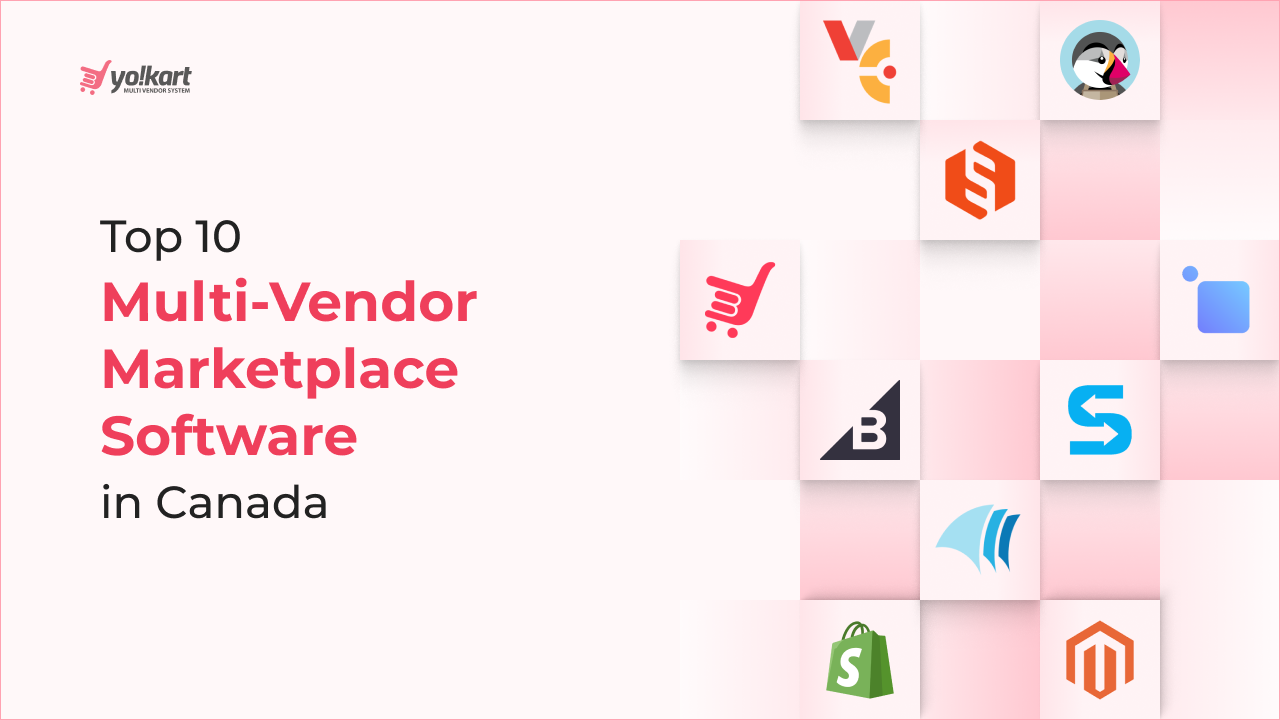The traditional eCommerce paradigm, centered around a single brand, is undergoing a profound evolution. In this increasingly competitive market, a new era of collaborative eCommerce is dawning, driven by the transformative power of multi-vendor marketplaces. A multi-vendor marketplace transforms a single online store into a bustling digital marketplace, bringing together diverse products, sellers, and customers in a seamless digital experience.
With this, the Canadian eCommerce industry is also booming. The projected market volume is expected to reach an impressive $101.27 billion by 2029, up from $72.15 billion in 2025 at a CAGR of 8.84% over the period—representing a lucrative business opportunity to build a multi-vendor marketplace in Canada and position your platform in the industry.
However, building a multi-vendor platform requires robust eCommerce marketplace software to manage several eCommerce operations, such as vendor onboarding, product management, secure transactions, and customer engagement—all while ensuring a frictionless experience for each stakeholder involved.
Hence, in this guide, we’re cutting through the noise to highlight the top 10 multi-vendor marketplace software in Canada.
Table of Contents
What is a Multi-Vendor Marketplace?
A multi-vendor marketplace is an online platform where multiple independent sellers or vendors can list and sell their products or services through a single storefront. A multi-vendor marketplace enables third-party sellers to create their own product listings.
In contrast, the marketplace owner oversees operations, manages transactions, and earns revenue through commissions, subscriptions, or listing fees, unlike traditional eCommerce stores that are operated by a single retailer.
While buyers enjoy a diverse selection of products from various sellers, often with competitive pricing, vendors gain access to a large customer base without having to invest in building their own online store.
Here are a few such benefits of a multi-vendor marketplace:
1. Diverse Product Selection: Customers can access a wider range of products and brands from different sellers in one place.
2. Global Reach: Sellers can reach a broader customer base without having to set up international shipping or deal with different currencies and languages.
3. Revenue Diversification: Marketplace owners generate income from multiple revenue streams that too via multiple vendors, reducing reliance on a single revenue stream.
4. Enhanced Customer Experience: Buyers benefit from competitive pricing, reviews, and a convenient shopping experience across multiple categories.
5. Lower Operational Costs: The zero-inventory business model allows business owners to eliminate the need for physical stock, warehousing, and inventory management.
Top Multi-Vendor Marketplaces in Canada
Canada hosts a variety of multi-vendor marketplaces that cater to diverse customer needs. Here are some notable examples of multi-vendor marketplaces in Canada:
- Amazon (amazon.ca): Amazon is one of the largest online marketplaces worldwide, and its Canadian branch is no exception. It offers a wide variety of products from electronics to household goods, and third-party vendors can list their products alongside Amazon’s own offerings.
- Best Buy: Specializing in electronics and appliances, Best Buy, Canada’s online marketplace features products from various brands—along with customer reviews and ratings.
- Hudson’s Bay: A historic Canadian retailer, Hudson’s Bay operates an online marketplace offering a wide selection of products, including clothing, home goods, and beauty products.
- Well (well.ca): Established in 2008, Well.ca is an online retailer offering a wide range of products across categories like health, beauty, and baby care. The company operates distribution centers in Guelph and Calgary, serving customers across Canada and the United States.
- Costco: While primarily a warehouse club, Costco’s online marketplace allows third-party sellers to list a wide range of products, from electronics to kitchen appliances, making it a popular multi-vendor platform for Canadian consumers.
- Canadian Tire: Known for its diverse offerings across categories like automotive, home improvement, and outdoor goods, Canadian Tire’s marketplace also features products from various vendors, particularly in the home and lifestyle categories.
Launch a Multi-Vendor Marketplace in Canada Similar to Amazon or Hudson’s Bay
Why Choose eCommerce Marketplace Software to Build a Multi-Vendor Marketplace?
Launching a multi-vendor marketplace from scratch is a complex process that requires a substantial investment in technology, infrastructure, time, money, and development expertise. Whereas, a multi-vendor eCommerce software solution streamlines this development journey by offering a robust, scalable, and feature-rich foundation tailored for marketplace operations.
Here’s how such software facilitates the development of a scalable and feature-rich multi-vendor marketplace:
1. Accelerated Time-to-Market: Developing a multi-vendor marketplace from the ground up demands months—if not years—of planning, coding, and testing. A multi-vendor marketplace software eliminates these roadblocks with ready-to-deploy solutions that allow businesses to launch quickly. This allows businesses to enter the market swiftly, capitalize on emerging trends, and gain a competitive edge.
2. Feature-Rich & Scalable Infrastructure: Multi-vendor eCommerce software solutions come equipped with essential marketplace functionalities, including vendor onboarding, commission management, product catalog management, and order processing. Moreover, these solutions offer extensive scalability, ensuring seamless growth as vendors, customers, listings, and transactions increase over time.
3. Cost Effectiveness: Custom-built marketplaces demand high development and maintenance costs, often running into hundreds of thousands of dollars. Conversely, multi-vendor eCommerce software solutions provide a cost-efficient alternative, offering a ready-to-use framework at a fraction of the cost. Moreover, most software solutions also offer a scalable pricing model—ranging from one-time purchases to SaaS-based subscription plans.
4. No Technical Expertise Required: Not all businesses have the technical expertise to build a multi-vendor marketplace from scratch. Modern multi-vendor marketplace software with a pre-built framework is designed with user-friendly interfaces, allowing you to develop a multi-vendor marketplace without any prior coding knowledge required. This empowers entrepreneurs and enterprises alike to build a multi-vendor marketplace in Canada with ease.
5. Security & Compliance: Cybersecurity threats and compliance requirements pose significant challenges to online marketplaces. Multi-vendor marketplace software solutions include built-in security protocols, PCI compliance, GDPR adherence, and fraud prevention mechanisms, ensuring safe transactions and data protection.
10 Popular Multi-Vendor Marketplace Software in Canada
Choosing the right multi-vendor marketplace software in Canada can be quite overwhelming. Here are a few popular software solutions to help you choose the right one for your multi-vendor marketplace:
1. Yo!Kart
Yo!Kart is a scalable multi-vendor marketplace software designed to help you build a multi-vendor marketplace across the globe. It offers a feature-rich platform with built-in tools to manage vendors, products, orders, and payments efficiently. With a robust clientele, the software excels in providing reliable support to businesses, be it a startup, SMBs, or a large enterprise to build a feature-rich, scalable multi-vendor marketplace.
Key Highlights:
- 100% white labeling capabilities to rebrand the platform.
- Offers flexibility over hosting with its self-hosted nature.
- Supports multiple payment options, enhancing customer convenience.
- Unlike SaaS models, Yo!Kart provides complete ownership of the platform at a one-time upfront payment.
- Affordable solutions with prices starting from just $499.
- Provides insightful business data to drive informed decisions.
- Offers extensive customization options to align with business-specific needs.
- Facilitates global expansion by incorporating features such as multi-lingual & multi-currency support, etc.
- Secure one year of free technical support after the purchase.
Downsides:
- You’ll have to manage your own server or hosting since it is a self-hosted solution.
- The learning curve is quite high, considering the extensive feature set.
Ratings: 4.6/5 ⭐
Book a One-on-One Personalized Demo to Know More About Yo!Kart
2. Shopify Multi-Vendor Software
Shopify is a notable multi-vendor marketplace software that enables businesses to set up and manage online stores with ease. While Shopify is inherently a single-vendor solution, its functionality can be extended to support a multi-vendor marketplace through third-party applications such as Webkul’s Multi-Vendor Marketplace and the Multi-Vendor Marketplace app by PurpleTree. This allows businesses to transform their Shopify store into a thriving multi-vendor ecosystem.
Key Highlights:
- Reduced startup costs compared to building a marketplace from scratch
- Built-in tools for vendor management and commission structures
- Automated features for order processing and inventory tracking
- Built-in payment processing through Shopify Payments and integration with multiple payment gateways
Downsides:
- The ongoing subscription fees can be costly since it is a SaaS-based solution.
- Shopify’s customization options are somewhat limited compared to open-source solutions.
- Not designed as a native multi-vendor platform, requires third-party apps and customizations to enable marketplace functionality.
- Limited multi-vendor features out-of-the-box, requiring reliance on plugins that can impact site performance.
- While apps offer additional features, they come with added costs and possible integration issues.
Ratings: 4.5/5 ⭐
3. Sharetribe
Sharetribe is one of the recognized no-code/low-code solutions specifically created to help entrepreneurs and organizations launch custom marketplaces quickly and efficiently. Unlike other multi-vendor eCommerce software solutions that require significant adaptation to support multiple vendors, Sharetribe was built with marketplace functionality at its core. Businesses can also choose the level of control and scalability they need with its two distinct offerings—Sharetribe Go for fast deployment with no coding, and Sharetribe Flex for fully customizable experiences via APIs.
Key Highlights:
- No-code setup with quick deployment.
- Built-in payment processing via Stripe with commission structures.
- Custom UI/UX and workflows with Sharetribe Flex.
- Ideal for niche marketplaces and service-based platforms.
Downsides:
- Restricted options for personalizing the multi-vendor marketplace.
- Very few custom themes available.
- Basic customization requires additional payments beyond the base plan.
- Multiple currency conversions lead to high fees.
- Higher costs for basic features like domain configuration.
- Lack of adequate safeguards for preventing data loss.
- No bulk upload feature for large inventories.
Ratings: 4.4/5 ⭐
4. CS-Cart
CS-Cart is also a self-hosted, multi-vendor marketplace software that has earned a strong global reputation for its feature-rich platform and administrative control. Designed specifically for managing multiple vendors under one digital roof, it allows business owners to oversee vendors, products, payments, and logistics from a unified, intuitive interface. Moreover, Its architecture supports high-volume operations and varied product types, from consumer goods to B2B services.
Key Highlights:
- Fully independent vendor dashboards and inventory management.
- Real-time vendor payouts, flexible commission settings, and withdrawal management.
- Wide ecosystem of add-ons, including SEO, analytics, and loyalty tools.
- Advanced commission logic and revenue models.
Downsides:
- Assistance gets expensive, once support expires after an initial period.
- Requires more technical experience than many small business owners have.
- Initial pricing is high compared to competitors.
- Many essential features require purchasing separate add-ons.
- Outdated documentation can be hard to understand.
Ratings: 4.6/5 ⭐
5. BigCommerce
BigCommerce is a widely recognized SaaS-based multi-vendor eCommerce software best known for its enterprise-grade performance, extensibility, and seamless integrations. While it does not support multi-vendor functionality natively, it becomes a formidable marketplace solution when paired with third-party apps such as Webkul, Multi-Vendor Marketplace by CedCommerce, or custom API integrations. Additionally, it offers best-in-class uptime, scalable infrastructure, and robust APIs that support complex workflows and integrations.
Key Highlights:
- Built-in SEO and performance optimization.
- Full app ecosystem to extend functionality (e.g., tax automation, shipping).
- Extensible via APIs for custom marketplace logic.
- Highly secure, PCI-compliant SaaS infrastructure.
Downsides:
- Lacks built-in marketplace functionality and requires third-party apps or custom development.
- Multi-vendor features are not part of BigCommerce’s core offering.
- Complex workflow customization can be challenging for beginners.
- Revenue-based pricing tiers force unexpected plan upgrades as the business grows.
- Steeper learning curve due to extensive feature set.
- Managing inventory across multiple vendors can be difficult.
Ratings: 4.4/5 ⭐
6. Virto Commerce
Virto Commerce is an enterprise-grade, open-source eCommerce marketplace software built with scalability and flexibility in mind. It was developed to support large-scale B2B operations and complex multi-vendor ecosystems. Designed with a composable commerce architecture, Virto enables businesses to tailor every aspect of their marketplace—from product catalogs and pricing rules to vendor roles and logistics flows. It’s especially well-suited for businesses operating in regulated industries, selling configurable products, or managing supplier networks.
Key Highlights:
- Multi-vendor support with full control over vendor roles.
- Sophisticated pricing models, product catalog management, and order workflows.
- White-label and multi-brand marketplace support.
Downsides:
- Challenging initial setup, taking time to configure.
- Enterprise-focused pricing models may not suit smaller businesses.
- Limited public case studies and implementation examples.
- Systems can experience downtime due to lack of centralized issue resolution.
- Limited customization options.
Ratings: 4.6/5 ⭐
7. Shuup
Shuup is a full-featured multi-vendor marketplace software built for versatility. Whether you’re launching a B2B wholesale marketplace, a product exchange platform, or a niche consumer marketplace, Shuup provides a solid foundation with advanced customization tools. Its modular architecture allows businesses to turn on or off based on their unique business model, keeping operations streamlined and efficient. Moreover, built with cutting-edge technology, Shuup offers strong developer support and a scalable backend—making it suitable for startups and mid-sized businesses alike.
Key Highlights:
- Customizable workflows and user permissions.
- Vendor onboarding and payout automation.
- Built-in tools for vendor management and communications.
- B2B enhancements such as RFQ and custom pricing.
Downsides:
- Complex interface that takes time to learn initially.
- Requires technical knowledge for customization and setup.
- Limited scalability for some features.
- Complex setup process requiring significant technical support.
- Takes considerable time to fix bugs, with some issues taking over 4 weeks to resolve.
Ratings: 3.8/5 ⭐
8. Nautical Commerce
Nautical Commerce is a sophisticated multi-vendor marketplace software built to accelerate digital transformation for retailers, distributors, and B2B enterprises. Positioned as a turnkey solution for B2B, B2C, and hybrid business models, Nautical caters especially well to retailers, distributors, and manufacturers that want to digitize their commerce infrastructure without building from scratch—substantially reducing go-to-market time. Its composable infrastructure supports integrations with existing ERP and CRM systems, making it ideal for mid to large-scale enterprises with complex operational needs.
Key Highlights:
- Automated vendor onboarding with self-service tools.
- Third-party APIs to integrate core enterprise systems.
- Centralized marketplace management with real-time reporting and analytics.
Downsides:
- Premium pricing may be out of reach for early-stage or small businesses.
- Requires strong technical involvement for configuration and integration.
- Limited variants per product listing in lower tiers.
- Restricted number of staff users and admin roles in basic plans.
Ratings: 4.6/5 ⭐
Build a Scalable Multi-Vendor Marketplace in Canada with the Best-in-Class Software
9. Magento
Magento—now under Adobe Commerce—remains one of the widely adopted eCommerce marketplace software. Though not inherently built as a multi-vendor marketplace, its extensive ecosystem of extensions—such as Webkul or CedCommerce—allows businesses to transform a Magento site into a fully functional, multi-vendor ecosystem.
Key Highlights:
- Advanced product and inventory management across multiple vendors.
- Scalable infrastructure built to support high-volume traffic and catalogs.
- Deep integration options for ERP, CRM, marketing automation, and analytics.
Downsides:
- Requires significant technical resources to implement and maintain.
- Can be costly when combining hosting, extensions, and development.
- Performance optimization is needed for high-traffic marketplaces.
- Steep learning curve for non-technical users.
Ratings: 4.2/5 ⭐
10. PrestaShop
PrestaShop is a well-established, open-source multi-vendor eCommerce software that offers a lightweight and accessible foundation for launching multi-vendor marketplaces. While not multi-vendor by default, PrestaShop supports this capability through reliable third-party modules, particularly from providers like Webkul and Knowband. Ideal for startups, SMEs, and entrepreneurs, PrestaShop is known for its user-friendly backend, active global community, and strong multilingual support.
Key Highlights:
- Rich marketplace ecosystem with third-party modules for vendor management.
- Easy-to-use dashboard for sellers and marketplace admins.
- Built-in SEO tools and marketing automation.
Downsides:
- Requires third-party modules to enable full multi-vendor functionality.
- Scalability can become a challenge for high-growth businesses.
- Limited out-of-the-box features compared to enterprise-grade platforms.
- May require additional security measures and performance tuning.
Ratings: 4.3/5 ⭐
Conclusion
In the rapidly evolving eCommerce landscape, the demand to build a multi-vendor marketplace in Canada has never been greater. As entrepreneurs and enterprises in Canada look to carve out a distinct presence in the eCommerce space, choosing the right eCommerce marketplace software to build a multi-vendor marketplace becomes a pivotal decision. Whether you’re a startup seeking rapid deployment or an established brand aiming to expand your ecosystem, the multi-vendor eCommerce software solutions mentioned above offer tailored functionalities that can align with your operational needs, budget, and growth vision.
Hence, invest in the right multi-vendor marketplace software based on your business requirements since choosing a reliable multi-vendor marketplace software is not merely a technical decision but a strategic move to position your marketplace as a dominant player in Canada’s digital economy.
FAQs
Q 1. What is an eCommerce marketplace software?
Ans. eCommerce marketplace software is a pre-built, ready-to-use solution that provides businesses with all the essential tools and features needed to create and manage an online store or marketplace. It allows entrepreneurs to quickly launch and scale their eCommerce ventures without requiring extensive technical knowledge or custom development.
Q 2. Which one is beneficial to build a multi-vendor marketplace: Custom Development or Multi-vendor eCommerce Software?
Ans. Choosing multi-vendor marketplace software to build a multi-vendor marketplace is generally more beneficial as it offers ready-made solutions for multi-vendor marketplaces, reducing development time and cost. It provides features like vendor management, commission tracking, and product listings out of the box, making it a practical choice for most businesses.
Q 3. What are the key factors to keep in mind before choosing a multi-vendor eCommerce software to build a multi-vendor marketplace?
Ans. Key factors to keep in mind before choosing a multi-vendor marketplace software to build a multi-vendor platform include:
- Scalability: Ensure the eCommerce marketplace software can grow as your marketplace expands.
- Customization Options: Check if you can tailor the software to fit your specific business needs.
- Vendor Management: Look for features to manage multiple vendors, their products, and commissions efficiently.
- Security: Ensure robust payment and data protection features in the software.
- Comprehensive Customer Support: Choose software with good customer support.
- Cost: Consider the pricing model if it fits within your budget and evaluate the cost-benefit ratio.
Q 4. How much does it cost to build a multi-vendor marketplace with eCommerce marketplace software?
Ans. The cost can vary based on the type of multi-vendor eCommerce software you choose. For SaaS software, you typically pay a monthly or yearly subscription fee. Whereas, for self-hosted solutions, the upfront cost is higher but often more cost-effective in the long term. A self-hosted solution with a lifetime license could cost anywhere from a few hundred to a thousand dollars, depending on the software and customization needs.
However, the cost to build a multi-vendor marketplace with Yo!Kart starts from just $499. For more details regarding the pricing, kindly check Yo!Kart’s pricing page.
Q 5. Which is the best eCommerce marketplace software to build a multi-vendor marketplace in Canada?
Ans. Yo!Kart is one of the top choices for building a multi-vendor marketplace in Canada, offering essential features like vendor management, easy customization, and a scalable platform for growing businesses. It is popular for its adaptability, scalability, cost-effectiveness, customizability, and robust clientele. Moreover, it is a self-hosted software that provides you the flexibility to host the server whether on-premise or third-party with a lifetime ownership.




